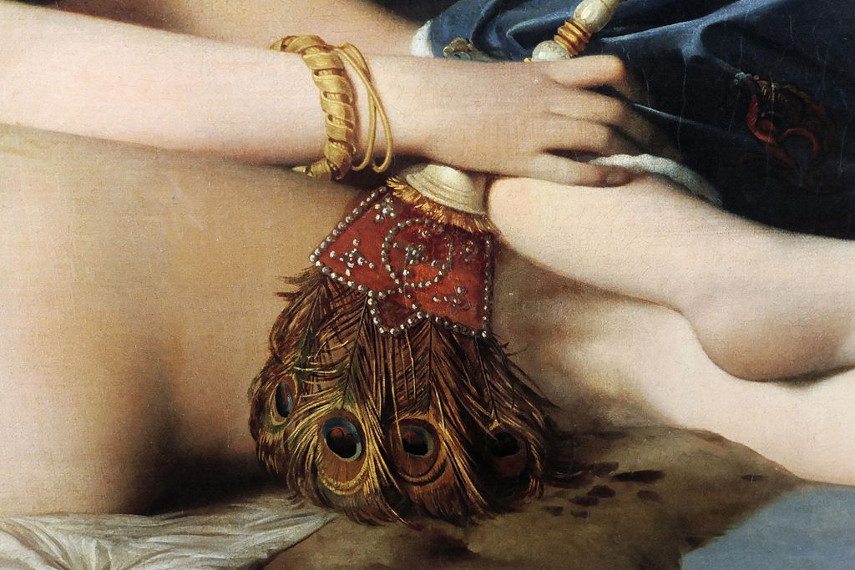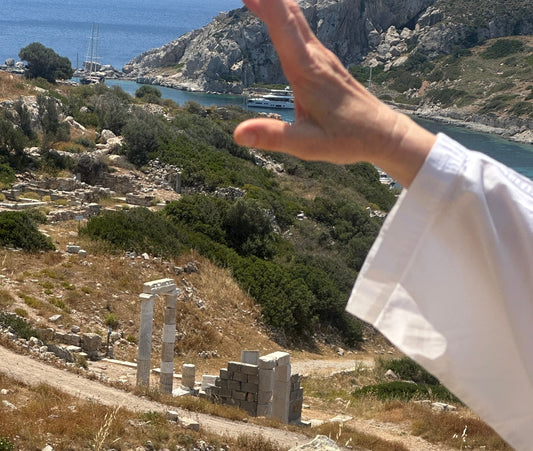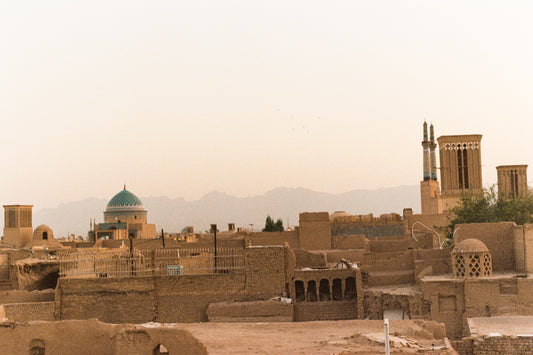There is a stately solitude to the Palmyra Hotel, shrouded in a canopy of ivy, situated on a busy street in Baalbek, of Lebanon’s Beqaa Valley. The hazy pollution from exhaust fumes of passing cars hovers and then, ever so slightly, lifts to reveal the colossal Baalbek ruins perched on a mound opposite the hotel. Nestled in the agriculturally rich plateau separating Lebanon and Syria, Baalbek was once an ancient Phoenician city, which was overtaken by the Romans in the 1st century AD. Considered to be the eastern jewel of imperial Rome, the well-preserved ruins of the grand Temple of Jupiter dwarf the spectator.
The Temples of Jupiter peeking through a guest room window.
The Temple of Jupiter, Baalbek.
Palmyra's left facing facade, worn with age.
Facing each other, the storied old hotel and the monumental temple appear to be in dialogue. And, like Lebanon itself, both the hotel and the temple have been subject to the vagaries of time: two world wars, a fifteen-year-long civil war, the 2006 war with Israel, and sectarian clashes.
Looking at the façade of the Palmyra, one wouldn’t guess that here Nina Simone imbibed heavily on six bottles of Veuve Clicquot before taking the stage at the Baalbek Music Festival. Or, that it was here that Lawrence of Arabia and Gertrude Bell clinked glasses on New Years’ Eve of 1900, no doubt discussing what the next century might hold. And yet, while passing through Palmyra’s double doors for the first time, one perceives a change in atmosphere; the air is grainy, the past is suddenly present. The hotel is saturated in memory.
Front entrance to the Hotel Palmyra.
Hotel Palmyra’s Beginnings
Built in 1878 by a Greek businessman from Constantinople, the Palmyra was designed to be a luxurious stopover for European dignitaries on their pilgrimage to Jerusalem. It soon became a destination hotel for the region, where treaties were signed, and royalty rubbed shoulders with jazz musicians and poets. During the WWII years, while Europe was being ravaged by war, the Palmyra, now under local ownership, became a haven for artists, writers, and musicians. The Baalbek International Music Festival was officially established in 1955, held in the forecourt of the Temple of Jupiter. Throughout the 1950s and 60s, the hotel pulsed with creative energy, entertaining the likes of Louis Armstrong, Ella Fitzgerald, Nina Simone, and Jean Cocteau.
Ella Fitzgerald performing in the Temple of Jupiter, Baalbek Music Festival.
Palmyra’s cozy bar, hung with travel, music, and film posters from Lebanon’s golden years..
Hard-drinking cosmopolitans mixed with colorful local characters, often congregating in the cozy confines of the hotel bar. By the time civil war came to Lebanon in the mid 1970s, the Palmyra was at risk of being abandoned until the current owner, Ali El Husseini, stepped in to rescue it. The running of Hotel Palmyra is now a family affair; El Husseini’s wife, Rima, and son, Hassan, are at the forefront of preserving its legacy.
Hard-drinking cosmopolitans mixed with colorful local characters, often congregating in the cozy confines of the hotel bar.
Guests of the Palmyra taking a sunrise walk through the Baalbek temples after a late night of revelry.
Today, the stately rooms of the once bustling hotel are hollowed; a dusty film coats the stone floors and original furnishings – the last renovation was in 1967. Occasionally the Palmyra greets visitors, intrepid travelers lured by stories of Lebanon’s golden years, but many more dare not. The Beqaa Valley is a Hezbollah stronghold, deterring both international and Lebanese tourists alike. Still, the Palmyra is a site to behold, an untouched artifact from Lebanon’s 20th century.
The Palmyra is a site to behold, an untouched artifact from Lebanon’s 20th century.
Roman busts in the front entrance.
A cabinet of ancient curiosities.
Room n. 30, Charles de Gaulle's quarters.
Recapturing the Past: A Walk through the Palmyra
Inside the grand entrance hall, red and yellow velvet settees mix with classical busts and archaeological fragments. Mother-of-pearl inlaid mirrors reflect light on the faded pink walls, which turn to shades of sugared almond in the morning sun. A vintage, green furnace — a recent addition — adds an almost pulpy feel to the room.
Ghassan’s office at the Hotel Palmyra.
Ghassan, the Palmyra’s manager.
Here too one meets for the first time Palmyra’s staff, personas ingrained in the spirit and history of the hotel. Ghassan is Palmyra’s manager; clad in a suede aviator jacket and wearing a gentle smile, he hand writes guest ledgers from his desk in old-school style. Abu Ali, who has been at the Palmyra for half a century, welcomes visitors at the door with tea and coffee.
Palmyra’s dining room once served 300 visitors a day.
Textiles and artifacts are hung on walls throughout the Palmyra.
A quiet corner of the once bustling dining room.
On spring afternoons, the air on the second-floor verandah overlooking the Roman ruins is thick with the scent of wisteria. It is easy to imagine why this place, shielded from intrusions and immersed in ancient history, inspired George Bernard Shaw to extend his stay for a month in the 1930s.
Jean Cocteau prints, hung on Persian carpets in the long hall leading to the dining room.
A temple facing room in pistachio green, with lemon yellow quilts and delicate mosquito nets.
All 40 of the hotel’s distinctive guest rooms have been carefully preserved and the presence of their former inhabitants is keenly felt. Hassan El Husseini becomes especially animated when talking about the unspoiled tranquility of number 19: the garden-facing room that Shaw exclusively stayed in. In the Annex, an adjacent building added to the hotel in the 1980s, rooms are awash with vibrant color – magenta walls, velvet floral coverlets, a floor-to-ceiling mother-of-pearl wardrobe that Rima found in a Damascus antique bazaar.
Mirror detail, Jean Cocteau’s room.
Fairuz’s suite in the Annex.
Fairuz, the famed Lebanese singer, regularly requested an elegant pistachio-hued room in the Annex during her stays in Baalbek. LEVANT was particularly tickled by Agatha Christie’s quarters. The space feels perfectly suited to the mystery writer: heavy velvet curtains create a muted light and double beds draped in wooly plaid blankets lend a spooky and bookish feel.
All 40 of the hotel’s distinctive guest rooms have been carefully preserved and the presence of their former inhabitants is keenly felt.
Bringing Art Back to Baalbek
It is exactly this untouched quality that has made the Palmyra a cult destination for hotel lovers and history buffs. While many designers and architects have approached the El Husseinis over the years with renovation plans, they were respectfully turned down.
Guest room details in the Annex.
Magenta walls in the Annex.
Vibrant velvet coverlets and a pearl inlaid closet, found by Rima in a Damascus antique bazaar.
Hassan El Husseini, who is planning an artist residency on the Palmyra’s grounds.
“There is a difference between renovation and rejuvenation: A subtle lift is all it needs,” remarks Hassan, so as not to “damage the hotel’s spirit.” Determined to preserve Palmyra’s unique atmosphere, while also encouraging a new era of arts and culture in Baalbek, Hassan is working on plans for an artist residency housed in a three-room building on hotel grounds. “Bring art back to Baalbek” is the mission.
Rima El Husseini herself is heavily involved in supporting local female artisans in Baalbek. The Beqaa valley has a rich craft tradition, a blend of Lebanese, Syrian, Palestinian, and Ottoman techniques and motifs. LEVANT is a privileged guest of the Hotel Palmyra during frequent trips to the valley, meeting with silver and embroidery artisans.
Since 2021, Lebanon experiences frequent electricity blackouts. It has become a part of daily life. Oftentimes the city of Baalbek goes dark, with the Palmyra being a singular source of light.
On such nights, the sky over the Palmyra becomes a deep blue canvas sprinkled with white star-dots, floodlighting the temples. From the hotel’s rooftop, with the soundtrack of Louis Armstrong’s “Stardust” animating the mind, this place continues to inspire and transport weary travelers as it did Rockefellers and Sheiks.
LEVANT’S PALMYRA PLAYLIST
Until you can visit the Palmyra yourself, songs to transport you…
- Puttin’ on the Ritz, Ella Fitzgerald
“Come let’s mix where Rockefellers walk with sticks”. - Stardust, Nat King Cole
LEVANT is partial to the 1940 Nat King Cole version for balmy summer nights. - In the Dark, Nina Simone
Nina famously drank six bottles of champagne at the Hotel Palmyra with her manager, before taking the stage at the Baalbek Music Festival. - Something Cool, June Christy
A perfect ode to an ice cold drink in a hotel bar. - Let’s Do It, Louis Armstrong & Oscar Peterson
A sultry, slowed down version of the well known classic. - You’re the Top, Cole Porter
We love the references to the Levant and ancient sites. - Bhebbak Ya Lebnan, Fairuz
The “soul of Lebanon” singing about her homeland.





























